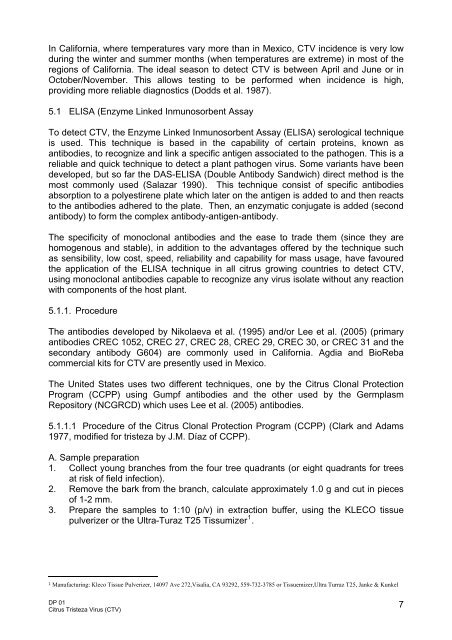NAPPO DIAGNOSTIC PROTOCOLS DP 01 Citrus Tristeza Virus (CTV)
NAPPO DIAGNOSTIC PROTOCOLS DP 01 Citrus Tristeza Virus (CTV)
NAPPO DIAGNOSTIC PROTOCOLS DP 01 Citrus Tristeza Virus (CTV)
- No tags were found...
Create successful ePaper yourself
Turn your PDF publications into a flip-book with our unique Google optimized e-Paper software.
In California, where temperatures vary more than in Mexico, <strong>CTV</strong> incidence is very lowduring the winter and summer months (when temperatures are extreme) in most of theregions of California. The ideal season to detect <strong>CTV</strong> is between April and June or inOctober/November. This allows testing to be performed when incidence is high,providing more reliable diagnostics (Dodds et al. 1987).5.1 ELISA (Enzyme Linked Inmunosorbent AssayTo detect <strong>CTV</strong>, the Enzyme Linked Inmunosorbent Assay (ELISA) serological techniqueis used. This technique is based in the capability of certain proteins, known asantibodies, to recognize and link a specific antigen associated to the pathogen. This is areliable and quick technique to detect a plant pathogen virus. Some variants have beendeveloped, but so far the DAS-ELISA (Double Antibody Sandwich) direct method is themost commonly used (Salazar 1990). This technique consist of specific antibodiesabsorption to a polyestirene plate which later on the antigen is added to and then reactsto the antibodies adhered to the plate. Then, an enzymatic conjugate is added (secondantibody) to form the complex antibody-antigen-antibody.The specificity of monoclonal antibodies and the ease to trade them (since they arehomogenous and stable), in addition to the advantages offered by the technique suchas sensibility, low cost, speed, reliability and capability for mass usage, have favouredthe application of the ELISA technique in all citrus growing countries to detect <strong>CTV</strong>,using monoclonal antibodies capable to recognize any virus isolate without any reactionwith components of the host plant.5.1.1. ProcedureThe antibodies developed by Nikolaeva et al. (1995) and/or Lee et al. (2005) (primaryantibodies CREC 1052, CREC 27, CREC 28, CREC 29, CREC 30, or CREC 31 and thesecondary antibody G604) are commonly used in California. Agdia and BioRebacommercial kits for <strong>CTV</strong> are presently used in Mexico.The United States uses two different techniques, one by the <strong>Citrus</strong> Clonal ProtectionProgram (CCPP) using Gumpf antibodies and the other used by the GermplasmRepository (NCGRCD) which uses Lee et al. (2005) antibodies.5.1.1.1 Procedure of the <strong>Citrus</strong> Clonal Protection Program (CCPP) (Clark and Adams1977, modified for tristeza by J.M. Díaz of CCPP).A. Sample preparation1. Collect young branches from the four tree quadrants (or eight quadrants for treesat risk of field infection).2. Remove the bark from the branch, calculate approximately 1.0 g and cut in piecesof 1-2 mm.3. Prepare the samples to 1:10 (p/v) in extraction buffer, using the KLECO tissuepulverizer or the Ultra-Turaz T25 Tissumizer 1 .1 Manufacturing: Kleco Tissue Pulverizer, 14097 Ave 272,Visalia, CA 93292, 559-732-3785 or Tissuemizer,Ultra Turraz T25, Janke & Kunkel<strong>DP</strong> <strong>01</strong><strong>Citrus</strong> <strong>Tristeza</strong> <strong>Virus</strong> (<strong>CTV</strong>)7













